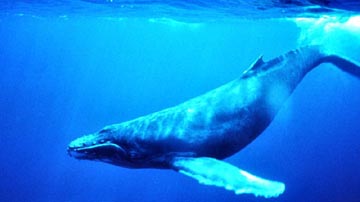800px-Humpback_Whale_underwater_shot.jpg

Nutrient rich waters off the coasts of California and Peru are teeming with life. Credit: Tanaka Juuyoh
If you’re looking for a can’t-miss fishing spot, it’s hard to beat the coastal waters of California and Peru. Thanks to a “flip” in the top layers of the Pacific Ocean, they’re some of the most productive fishing grounds in the world.
The “flip” is known as upwelling. It happens during the summer, when winds that blow parallel to the coastline push the water at the surface of the ocean. Earth’s rotation deflects these currents to the west, away from shore. As the warm surface water moves out, colder water from below rises to take its place.
These deeper waters are rich in nitrogen and phosphorous, which are key nutrients for the microscopic plants known as phytoplankton. With plenty of food and abundant sunshine, the phytoplankton stage a population explosion. They provide food for small animals, which in turn attract larger organisms. So the areas of upwelling soon teem with life. In fact, these regions account for only about one percent of the ocean surface, but about half of all the fish catch.
Not every year is a great one for these regions, though. When there’s an El Niño, for example, warmer water snuggles close to the South American coastline, blocking much of the upwelling and causing a drop in productivity. That’s when the fishing fleets have to be careful. If they don’t cut back, they can overfish a region and not leave enough stock to replenish the population when El Niño is over. In effect, that can turn a “can’t-miss” fishing spot into a dry hole.

